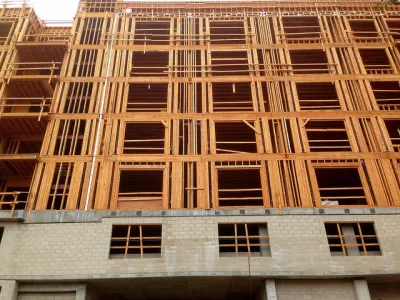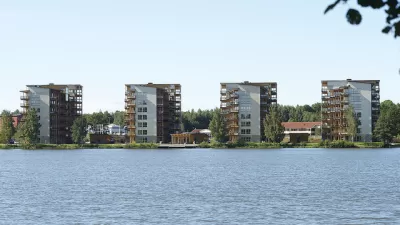In an era where cities all over the world are allowing larger and taller wood-framed buildings, the city of Sandy Springs just approved sweeping limitations on the construction practice.

"Over the objections of the wood products industry, the Sandy Springs City Council has approved a building code change to prohibit wood-framed construction for future buildings taller than three stories and larger than 100,000 square feet," reports David Ibata.
"Supporters of the change cited safety issues, as well as matters of quality, durability and longevity of buildings in turning to steel and masonry," according to Ibata. Objectors include the American Wood Council and Georgia Forestry Association.
Writing for Construction Dive, a construction industry newsletter, Kim Slowey surveys the world for examples of the construction industry finding new, larger-scale uses for wood construction. We at Planetizen have noted the example of Toronto, Ontario, which relaxed its wood-framed building standards to allow for buildings up to six stories high. Paris, France approved a wood-framed building that will reach 35 stories high back in 2015. The T3 project in Minneapolis targets a height of seven stories. The latter project is nearing completion, as is visible on its very own live feed construction camera.
Slowey finds examples from Stockholm, Sweden, and London, U.K, of approved projects that will push the boundaries of previous wood-framed buildings. In the United States, according to Slowey, the U.S. Department of Agriculture sponsored the U.S. Tall Wood Building Competition last year.
An article by Ely Portillo for The Charlotte Observer digs more into the implication of the actions of the Sandy Springs City Council by imagining the consequences if the city of Charlotte were to approve similar regulations. If the city of Charlotte instituted the same regulations, writes Portillo, it "would effectively exclude most of the new apartments under construction...except for uptown high rises built with concrete and steel."
FULL STORY: Sandy Springs bars wood framing in mid-rise construction

Alabama: Trump Terminates Settlements for Black Communities Harmed By Raw Sewage
Trump deemed the landmark civil rights agreement “illegal DEI and environmental justice policy.”

Study: Maui’s Plan to Convert Vacation Rentals to Long-Term Housing Could Cause Nearly $1 Billion Economic Loss
The plan would reduce visitor accommodation by 25% resulting in 1,900 jobs lost.

Why Should We Subsidize Public Transportation?
Many public transit agencies face financial stress due to rising costs, declining fare revenue, and declining subsidies. Transit advocates must provide a strong business case for increasing public transit funding.

Paris Bike Boom Leads to Steep Drop in Air Pollution
The French city’s air quality has improved dramatically in the past 20 years, coinciding with a growth in cycling.

Why Housing Costs More to Build in California Than in Texas
Hard costs like labor and materials combined with ‘soft’ costs such as permitting make building in the San Francisco Bay Area almost three times as costly as in Texas cities.

San Diego County Sees a Rise in Urban Coyotes
San Diego County experiences a rise in urban coyotes, as sightings become prevalent throughout its urban neighbourhoods and surrounding areas.
Urban Design for Planners 1: Software Tools
This six-course series explores essential urban design concepts using open source software and equips planners with the tools they need to participate fully in the urban design process.
Planning for Universal Design
Learn the tools for implementing Universal Design in planning regulations.
Smith Gee Studio
Alamo Area Metropolitan Planning Organization
City of Santa Clarita
Institute for Housing and Urban Development Studies (IHS)
City of Grandview
Harvard GSD Executive Education
Toledo-Lucas County Plan Commissions
Salt Lake City
NYU Wagner Graduate School of Public Service



























